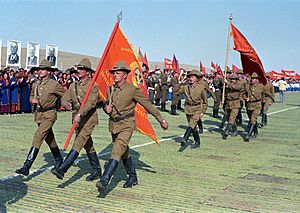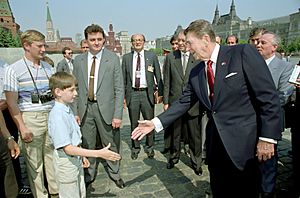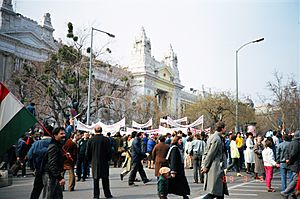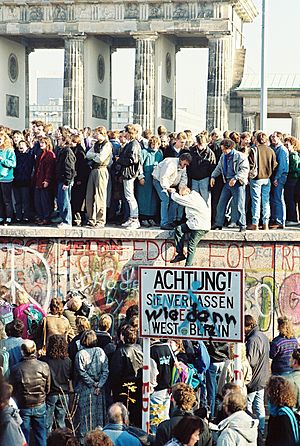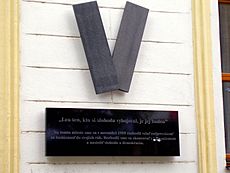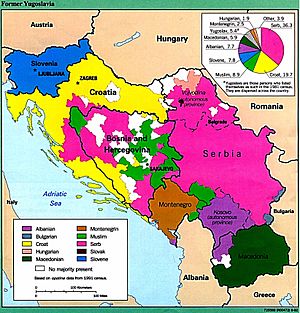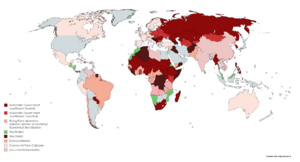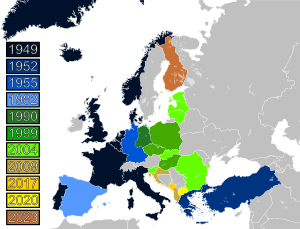Revolutions of 1989 facts for kids
Quick facts for kids Revolutions of 1989 |
|
|---|---|
| Part of the Cold War (until 1991) | |
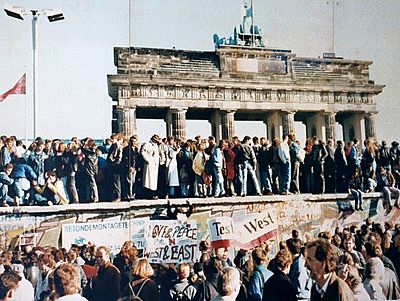
The fall of the Berlin Wall in November 1989
|
|
| Date | 16 December 1986 – 28 June 1996 (9 years, 6 months, 1 week and 5 days) Main phase: 12 May 1988 – 26 December 1991 (3 years, 7 months and 2 weeks) |
| Location | |
| Caused by |
|
| Methods | (mostly civil disobedience) |
| Resulted in | End of most communist states
|
| Also known as Fall of Stalinism, Fall of Soviet system, Fall of Marxism-Leninism, Collapse of Communism, Collapse of Socialism, Fall of Socialism | |
The Revolutions of 1989, also known as the Fall of Communism, were a series of big changes that happened around the world. These changes led to the end of most communist states (countries ruled by a single communist party). This time is also sometimes called the Fall of Nations or the Autumn of Nations.
These events led to the breakup of the Soviet Union, which was the biggest communist country. Many other communist governments around the world also ended, some peacefully and some with fighting. These changes greatly shifted the world's balance of power. They marked the end of the Cold War and the start of a new time in history.
The first protests began in Kazakhstan in 1986. The last big change happened in 1996 when Ukraine adopted a new constitution. The main changes happened in Eastern Europe, starting in Poland in 1988. The movement then spread to Hungary, East Germany, Bulgaria, Czechoslovakia, and Romania.
In June 1989, a trade union called Solidarity won elections in Poland. This led to communism ending peacefully there. Also in June 1989, Hungary started taking down its border fence with Austria, which was part of the "Iron Curtain". This helped other countries in the Eastern Bloc to break free.
Mass protests in East Germany led to the fall of the Berlin Wall in November 1989. This was a huge moment that helped German reunification happen in 1990. Most of these changes happened peacefully, with people protesting against one-party rule. Romania was the only country where people used violence to overthrow their communist government. The Cold War is often said to have ended on 3 December 1989, but many historians say it truly ended when the Soviet Union broke up on 26 December 1991.
The Soviet Union itself changed to a multi-party system in 1990. It then broke up in December 1991. This created 15 new independent countries. The rest of the Soviet Union became the Russian Federation.
Albania and Yugoslavia also stopped being communist between 1990 and 1992. Yugoslavia then split into five new countries. Czechoslovakia peacefully split into the Czech Republic and Slovakia in 1993. North Korea officially stopped following Marxism–Leninism in 1992.
The changes in Europe also affected many other socialist countries around the world. In China, large protests in Tiananmen Square in 1989 did not lead to major political changes. However, images of these protests inspired people elsewhere. Three Asian countries—Afghanistan, Cambodia, and Mongolia—stopped being communist by 1993. Eight countries in Africa also ended their communist systems.
Only four countries kept their communist parties in power: China, Cuba, Laos, and Vietnam. However, these countries later made economic changes to allow some market economy ideas. Many former Eastern Bloc countries joined NATO and the European Union. This led to stronger economic and social ties with Western Europe and North America.
Contents
Why Did These Changes Happen?
Poland's Solidarity Movement
Labour problems in Poland in 1980 led to the creation of an independent trade union called Solidarity. This group was led by Lech Wałęsa. It became a strong political force. However, in December 1981, the Polish Prime Minister, Wojciech Jaruzelski, declared martial law in Poland. He stopped Solidarity and put its leaders in prison.
Mikhail Gorbachev's Reforms
Some Eastern Bloc countries tried small reforms in the past. But when Mikhail Gorbachev became the Soviet leader in 1985, he pushed for bigger changes. He wanted to fix the Soviet Union's weak economy. The country was spending too much on its military and secret police.
Gorbachev started two main policies: glasnost (openness) and perestroika (economic restructuring). By 1989, the Soviet Union even had its first elections with more than one candidate. Gorbachev encouraged other communist leaders to make similar changes. But many hardline leaders, like Erich Honecker of East Germany, did not want to change. They thought Gorbachev's reforms would not last.
Problems in Soviet Republics

By the late 1980s, people in places like the Baltic states wanted more freedom from Moscow. The Soviet government was losing control. Protests started in Kazakhstan in 1986. In November 1988, Estonia declared its sovereignty, meaning it wanted to rule itself.
The Chernobyl disaster in 1986 also had a big impact. It showed how much the Soviet government was hiding information. This made people trust the government even less. The disaster also cost a huge amount of money, which hurt the already weak Soviet economy.
Solidarity's Growing Power
Solidarity continued to work secretly, supported by the Catholic Church. By the late 1980s, it was strong enough to challenge the government. Strikes in 1988 forced the government to talk with Solidarity. In March 1989, they agreed to create a new parliament with two parts. The Senate would be elected by the people.
On 7 July 1989, Mikhail Gorbachev said that the Soviet Union would not use force against other Soviet-bloc nations. This was called the "Sinatra Doctrine" because it meant each country could do things "My Way." This was a huge change. Poland became the first country to break free from Soviet control.
Fall of Dictatorships Elsewhere
The changes in Europe also affected other dictatorships around the world. For example, in 1986, the People Power Revolution in the Philippines peacefully overthrew dictator Ferdinand Marcos. The South African apartheid system and Pinochet's military rule in Chile also ended in the 1990s. Many other countries, like Ghana and South Korea, also became democracies.
Revolutions in Different Countries
Poland's Path to Freedom
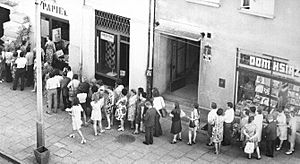
In 1988, a new wave of strikes hit Poland. Workers demanded that Solidarity be made legal again. On 31 August 1988, Solidarity leader Lech Wałęsa was invited to talks with the communist government.
In February 1989, formal "Round Table" talks began. On 4 April 1989, an agreement was signed. This made Solidarity legal and set up partly free elections for 4 June 1989. Solidarity won a huge victory, taking almost all the seats they could.
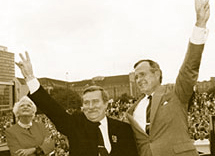
On 15 August 1989, the communist party's partners in government switched their support to Solidarity. This meant a non-communist prime minister would take power. On 19 August 1989, Tadeusz Mazowiecki, a Solidarity supporter, became Prime Minister of Poland. The Soviet Union did not protest. This was the first non-communist government in the Eastern Bloc.
On 29 December 1989, Poland changed its official name from the People's Republic of Poland to the Republic of Poland. The communist party dissolved itself in January 1990. In 1990, Wałęsa became Poland's president. The Warsaw Pact (a military alliance of communist countries) was dissolved in July 1991. The last Russian troops left Poland in September 1993.
Hungary Opens Its Borders
Hungary followed Poland's lead. It had already made some small reforms. In May 1988, a new, more open communist leader, Károly Grósz, took over. In November 1988, Miklós Németh became Prime Minister. In January 1989, the parliament passed laws allowing more freedom, like freedom of the press.
On 2 May 1989, Hungary started taking down its 240-kilometer-long border fence with Austria. This was a big step in breaking down the Iron Curtain. This made it easier for thousands of East Germans and Czechoslovaks to escape to the West.
On 16 June 1989, former Prime Minister Imre Nagy, who was executed for his role in the 1956 Hungarian uprising, was given a large public funeral. This showed that the government was changing its view of history.
The opening of the border between Austria and Hungary in August 1989 led to a huge number of East Germans leaving their country. This event, called the Pan-European Picnic, showed that the Eastern Bloc was falling apart. The communist government in Hungary was formally ended on 23 October 1989. The last Soviet troops left Hungary in June 1991.
East Germany and the Berlin Wall
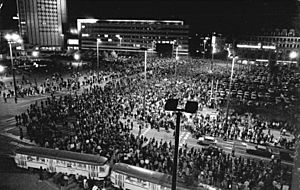
Hungary's decision to open its border greatly affected East Germany. Thousands of East Germans escaped to the West through Hungary. By September 1989, over 30,000 East Germans had left. East Germany then closed its border with Hungary. Many East Germans then tried to escape through Czechoslovakia.
Mass protests, called "Monday demonstrations," grew in cities like Leipzig. On 2 October, 10,000 people protested. The communist leader, Erich Honecker, ordered the military to shoot protesters. But on 9 October, 70,000 citizens protested in Leipzig, and the authorities refused to open fire.
On 18 October, Honecker was removed from power and replaced by Egon Krenz. But the protests kept growing. On 23 October, 300,000 people protested in Leipzig.
On 4 November, half a million people protested in Berlin. Unable to stop the flow of refugees, East German authorities finally allowed citizens to travel directly to West Berlin and West Germany on 9 November 1989. This was announced by mistake, but hundreds of thousands of people rushed to the border. The border guards, confused and unwilling to use force, opened the gates. People started tearing down the Berlin Wall.
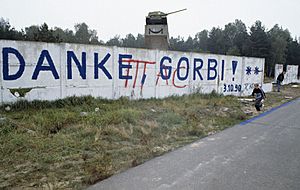
On 1 December, the East German parliament removed the communist party's leading role from the constitution. On 3 October 1990, the two German countries were finally reunited. This was a huge change in international relations. The last Russian troops left East Germany in September 1994.
Czechoslovakia's Velvet Revolution
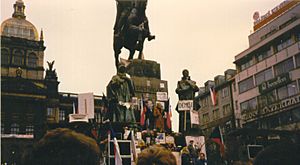
The "Velvet Revolution" was a peaceful change of power in Czechoslovakia. On 17 November 1989, police stopped a student protest in Prague. This sparked a series of large protests. By 20 November, half a million people were protesting in Prague.
On 24 November, the entire Communist Party leadership resigned. On 28 November, the Communist Party announced it would give up power. Barbed wire was removed from the border with West Germany and Austria. On 10 December, President Gustáv Husák appointed the first non-communist government since 1948 and then resigned. Václav Havel became President of Czechoslovakia on 29 December 1989. The last Soviet troops left Czechoslovakia in June 1991.
Bulgaria's Peaceful Transition
In October and November 1989, protests for political reform happened in Sofia. On 10 November 1989, Bulgaria's long-time leader, Todor Zhivkov, was removed from power by his own party. He was replaced by a more open communist, Petar Mladenov. The new government allowed free speech and protests.
Mladenov announced on 11 December 1989 that the Communist Party would give up its power. Multi-party elections would be held the next year. In February 1990, the Bulgarian parliament removed the Communist Party's "leading role" from the constitution. The Communist Party renamed itself the Bulgarian Socialist Party. In June 1990, the first free elections since 1931 were held.
Romania's Violent Revolution
Romania was the last hard-line communist country in the Warsaw Pact. Its leader, Nicolae Ceaușescu, was re-elected in November 1989. On 16 December, protests started in Timișoara after a local minister was arrested.
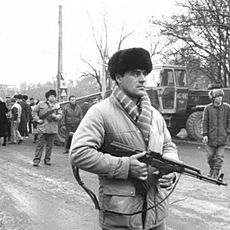
On 21 December, Ceaușescu ordered a big rally in Bucharest to support him. But the crowd booed him. People's anger boiled over, and protests spread. At first, security forces shot protesters. But on 22 December, the Romanian military switched sides. This happened after the defense minister died, which many believed was a murder.
Ceaușescu and his wife, Elena, tried to escape by helicopter but were captured. On Christmas Day, Romanian television showed them being tried quickly and then executed by firing squad. An interim government took over and announced elections for May 1990. The Romanian Revolution was the bloodiest of the 1989 revolutions, with over 1,000 people dying.
Yugoslavia's Breakup
Yugoslavia was not part of the Warsaw Pact. It had its own type of communism. It was a country with many different ethnic groups. After its leader, Josip Broz Tito, died in 1980, tensions between these groups grew.
In the late 1980s, groups in Slovenia pushed for democracy. In January 1990, the main communist party of Yugoslavia broke up. The Slovenian and Croatian communist parties then held free elections with other parties.
In April 1990, democratic parties won elections in Slovenia and Croatia. The leaders of Slovenia and Croatia started planning to leave Yugoslavia. This led to several wars, including the Ten-Day War in Slovenia (1991), the Croatian War of Independence (1991–1995), and the Bosnian War (1992–1995).
Albania's Gradual Opening
In Albania, the leader Enver Hoxha died in 1985. His successor, Ramiz Alia, slowly started to open up the country. In 1989, protests began. The government allowed more freedom, including travel abroad. In March 1991, Albania held its first free elections since 1923.
Mongolia's Peaceful Revolution
Mongolia was closely linked to the Soviet Union. After its leader changed in 1984, some economic reforms were made. But people wanted bigger changes. The "Mongolian Revolution" was a peaceful revolution that ended 70 years of communism. It started with protests and hunger strikes.
Young people led the protests in the capital, Ulaanbaatar. They demanded free elections and economic reform. They also used traditional Mongolian writing to show their national pride. On 4 March 1990, over 100,000 people protested. The communist leaders resigned on 9 March 1990.
Mongolia held its first free elections on 29 July 1990. A new constitution was adopted in 1992. The last Russian troops left Mongolia in December 1992.
China's Protests
While China did not have a revolution like the European countries, it had large protests for democratic reforms in 1989. Chinese leader Deng Xiaoping had started economic reforms, but political changes were slow.
The protests started after the death of Hu Yaobang, a leader who supported reforms. On 15 April 1989, students gathered in Tiananmen Square. The protests lasted for seven weeks.
When Mikhail Gorbachev visited China in May, many foreign news reporters came. Their stories about the protesters inspired people in other parts of the world. However, on 4 June 1989, the Chinese military used force to end the protests in Tiananmen Square. Many civilians were killed or injured. This event led to some economic changes in China, but not political ones.
The Malta Summit
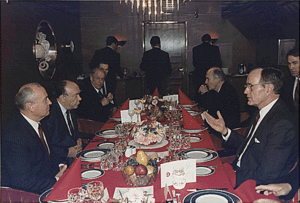
The Malta Summit was a meeting between U.S. President George H. W. Bush and Soviet leader Mikhail Gorbachev. It happened on 2–3 December 1989, just weeks after the fall of the Berlin Wall. This meeting helped to officially end the Cold War.
The Soviet Union Breaks Up
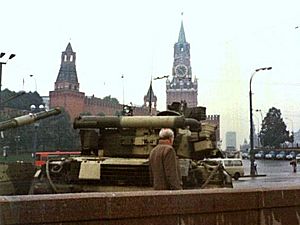
On 1 July 1991, the Warsaw Pact was officially dissolved. This showed that the Cold War was truly over. As the Soviet Union pulled its troops out of Europe, its own republics started demanding independence. Lithuania, Estonia, Latvia, and Armenia declared independence. The Soviet government tried to stop them, even sending troops to Lithuania in January 1991, which caused deaths.
Gorbachev's reforms had accidentally awakened strong national feelings in the different parts of the Soviet Union. The economy was also failing. One by one, the republics started to make their own laws. In 1990, the Communist Party had to give up its power.
In August 1991, a group of hardline Soviet leaders tried to overthrow Gorbachev in a coup. But Boris Yeltsin, the president of the Russian republic, rallied people against the coup, and it failed. Gorbachev's power was greatly weakened. He resigned as head of the Communist Party, and the Party was banned. The Baltic states were granted independence on 6 September.

Over the next three months, more republics declared independence. On 8 December, leaders from Russia, Ukraine, and Belarus signed an agreement saying the Soviet Union no longer existed. Gorbachev resigned on 25 December. The Soviet Union officially broke up into fifteen new countries. This ended the world's largest socialist state.
Baltic States Gain Freedom
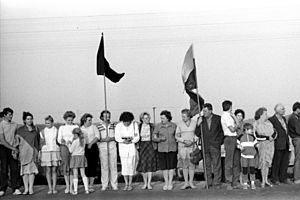
Estonia, Latvia, and Lithuania had peaceful movements called the "Singing Revolution" between 1987 and 1991. They wanted to restore their independence from the Soviet Union. Estonia declared its sovereignty in November 1988, followed by Lithuania and Latvia in 1989.
These countries declared full independence in early 1990. The Soviet Union tried to stop them with force in 1991. But after the August 1991 coup failed, the Soviet Union recognized their independence on 6 September 1991.
Other Former Soviet Republics
- Belarus declared independence in August 1991.
- Moldova had a conflict over the region of Transnistria.
- Ukraine became independent in August 1991. Later, the Orange Revolution in 2004 brought more democratic changes.
Countries in the Caucasus
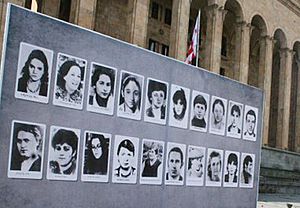
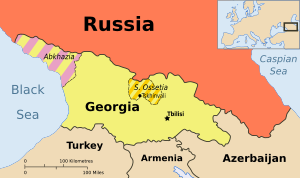
All countries in this region became independent in 1991.
- Georgia had protests and conflicts. Russia supported breakaway regions like South Ossetia and Abkhazia.
- Armenia and Azerbaijan fought a war over the Nagorno-Karabakh region.
Chechnya's Struggle
In Chechnya, a region within Russia, people wanted independence. A former Soviet general, Dzhokhar Dudayev, led a peaceful revolution. He was elected president and declared Chechnya's independence in November 1991. Russia invaded Chechnya in 1994, starting the First Chechen War. The Chechens fought back and signed a peace treaty in 1997. However, Chechnya later became part of Russia again.
Central Asian Countries
- Kazakhstan started its independence struggle with protests in 1986.
- Kyrgyzstan had its leader stay in power until 2005.
- Tajikistan had a civil war.
- Turkmenistan and Uzbekistan had leaders who stayed in power for a long time and were criticized for limiting freedoms.
Conflicts After the Soviet Union Broke Up
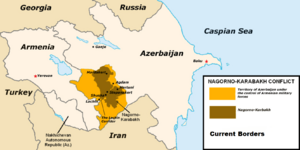
The breakup of the Soviet Union led to several conflicts. These include the Tajikistani Civil War, the First Nagorno-Karabakh War, and wars in Chechnya and Georgia. More recently, conflicts in Crimea and Donbass, and the 2022 Russian invasion of Ukraine, are also related to these changes.
Other Countries Affected
The reforms in the Soviet Union also led to big changes in other communist and socialist countries outside Europe.
Countries That Kept Socialist Systems (with reforms)
- China: Remained communist but continued big economic reforms.
- Cuba: Remained communist but faced economic hardship after losing Soviet support.
- Laos: Remained communist but made some economic changes.
- Vietnam: Remained communist but started economic reforms similar to China's.
Changes in Africa
Many African countries that had socialist governments also changed.
- Angola: The ruling party stopped following Marxism–Leninism in 1991.
- Ethiopia: The communist government was defeated in a civil war in 1991.
- Mozambique: Its civil war ended in 1992, and the ruling party moved towards democracy.
- Somalia: The communist government was overthrown in 1991, leading to a long civil war.
Changes in the Middle East
- South Yemen: Stopped following Marxism–Leninism in 1990 and united with North Yemen. This later led to a civil war.
Changes in Asia
- Afghanistan: The Soviet-supported government fell in 1992 after Soviet troops left.
- Cambodia: The Vietnam-supported government lost power after UN-backed elections in 1993.
- North Korea: Its leader Kim Il-sung died in 1994. The country faced a severe famine. All references to Marxism–Leninism were replaced by a new ideology called Juche in 2009.
Changes in Latin America
- Cuba: Faced severe economic problems after the Soviet Union broke up.
- Nicaragua: The Sandinista government lost elections in 1990.
Other Countries and Impacts
Many communist parties and groups around the world lost funding and support.
- In Australia, the Communist Party dissolved in 1991.
- In Germany, the Communist Party lost its funding from East Germany.
- In Italy, the Communist Party changed its name and split into new groups.
- In Malaysia, a communist insurgency ended in 1989.
At the same time, many anti-communist dictatorships, which the US had supported, also started to become democracies.
- Chile: Its military dictatorship ended in 1990, and democratic elections were held.
- South Korea: Large protests in 1987 led to the downfall of the government and the first democratic elections.
- Taiwan: Ended strict martial law in 1987 and began democratic reforms.
The United States became the world's only superpower after the Cold War. It encouraged more nations to adopt democracy.
Economic Changes

In communist countries, the government controlled everything. Factories had little reason to make what people wanted, leading to shortages. After communism fell, many countries faced a severe economic crisis. It was hard to switch from a government-controlled economy to a market economy.
For example, Russia's economy shrank a lot in the 1990s. Some countries, like Poland, used "shock therapy" reforms to quickly change their economies. Eventually, economies started to grow.
Many former communist countries in Central and Eastern Europe joined the European Union and NATO. This helped them to become more connected with Western Europe and North America.
China and Vietnam also made economic reforms, which helped millions of people escape poverty. India also started economic reforms in 1991. These changes led to a huge increase in the global workforce.
Remembering the Revolutions
Organizations
- Memorial: A group that records and shares information about the totalitarian past of the Soviet Union.
Events
- German Unity Day: A national holiday in Germany celebrating German reunification.
- Statehood Day and Independence and Unity Day in Slovenia.
- Day of National Unity in Georgia.
- National Day in Hungary.
- Constitution Day in Mongolia and Romania.
- Struggle for Freedom and Democracy Day in Slovakia and the Czech Republic.
- Restoration of Independence Day in Latvia.
Places
- Checkpoint Charlie Museum in Berlin, Germany
- DDR Museum in Berlin, Germany
- European Solidarity Centre in Poland
- Gdańsk Shipyard in Poland
- House of Terror in Hungary
- Lennon Wall in the Czech Republic
- Memento Park in Hungary
- Memorial of Rebirth in Romania
- Museum of Communism, Czech Republic
- Museum of Communism, Poland
- Museum of Occupations (Estonia)
- Museum of Occupation (Lithuania)
- Museum of the Occupation of Latvia
- Museum of Socialist Art in Bulgaria
- Museum of Soviet Occupation in Kyiv, Ukraine
- Museum of Soviet Occupation in Tbilisi, Georgia
- Stasi Museum in Berlin, Germany
Other Cultural Impacts
- The Soviet Story: A documentary film about the Soviet Union.
- The Singing Revolution: A documentary film about the peaceful protests in the Baltic states.
- "Wind of Change": A famous song by the German band Scorpions that celebrates the fall of communism.
See also
 In Spanish: Revoluciones de 1989 para niños
In Spanish: Revoluciones de 1989 para niños
- Arab Spring
- Civil resistance
- Colour revolutions
- Commonwealth of Independent States
- Enlargement of NATO
- Enlargement of the European Union
- Euromaidan
- History of Solidarity
- International relations since 1989
- January Events
- People Power Revolution
- Polish Round Table Agreement
- Revolutions of 1917–1923
- Rose Revolution
- 2022 Russian invasion of Ukraine


